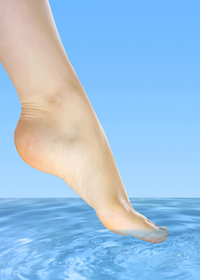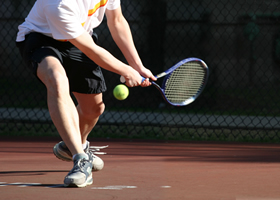Our Services
Ankle Dislocation
An ankle dislocation can occur when there is a good deal of force placed on the joint, resulting in an abnormal flexing that displaces the bones from their typical position. It is often caused by a sports injury due to trauma brought on by physical contact or quick pivots to change direction.
The symptoms of a dislocated ankle typically include intense pain at the joint that may radiate up the leg and a resultant inability to place pressure on the affected foot. Patients also commonly experience swelling, tenderness and a numb sensation around the ankle. A dislocation requires prompt medical attention as it can be potentially dangerous if the blood supply to the foot is compromised.
Treatment of an ankle dislocation generally begins with the RICE method, which stands for rest, ice, compression and elevation. This should help alleviate some of the inflammation and prevent further damage to the joint from occurring.
Flat Feet (Flat Arches)
 One in four adults in the U.S. has flat feet or fallen arches. Some people are born with flat feet, while others acquire it as they get older. The foot may be flat all the time or it may lose its arch when the person stands ("flexible flatfoot"). Many people with flat feet don't experience any symptoms. Others, however, suffer from heel or ankle pain, tired feet, bunions, arthritis in the foot or ankle, foot or ankle deformity, knee or back pain or other problems.
One in four adults in the U.S. has flat feet or fallen arches. Some people are born with flat feet, while others acquire it as they get older. The foot may be flat all the time or it may lose its arch when the person stands ("flexible flatfoot"). Many people with flat feet don't experience any symptoms. Others, however, suffer from heel or ankle pain, tired feet, bunions, arthritis in the foot or ankle, foot or ankle deformity, knee or back pain or other problems.
Adult Acquired Flat Foot begins during or after childhood and worsens over time. Causes include a tight Achilles tendon, obesity, "wear and tear" as a person ages, abnormalities higher up the leg and rupture of a tendon or ligament in the foot. The most common and serious cause of flat foot is Posterior Tibial Tendon Dysfunction, where the main tendon that supports the arch gradually weakens.
Foot Deformities
Many babies are born with foot deformities that occur as a result of birth trauma, developmental abnormalities and other factors, causing abnormal positioning and turning of the feet and/or toes. While many of these conditions are not painful, they can affect a child's development and ability to walk and require prompt, effective treatment. Some of the most common congenital foot deformities include:
- Metatarsus adductus
- Clubfoot
- Calcaneovalgus
- Vertical talus Polydactyly
- Syndactyly
- Overlapping toes
Treatment for congenital deformities often begins with nonsurgical methods such as manipulation and casting to restore the foot into a normal position and hold it in place as it heals. When these treatments are unsuccessful, surgery may be needed. Surgery for congenital deformities is often performed during the first year of life so that growth and development are not affected. The type of surgery performed depends on the location and severity of the deformity, but can often be done using minimally invasive techniques.
Foot Fractures
Treatment for a broken foot and/or toes depends on the severity of the fracture and may include nonsurgical and surgical treatments. Applying ice, resting the area and taking anti-inflammatory medication for pain are universal treatment options that can help reduce the severity and symptoms of your injury.
Mild fractures can often be treated by immobilizing the area with a cast or brace while it heals over the course of several weeks. More severe fractures may require surgery to restore the broken bone to its normal position so that proper healing can occur. This may require the use of metal pins, rods, screws or plates to hold the bone in place, which may or may not be removed once healing is completed.
Foot Infections

Treatment for nail diseases may include oral or topical medications. The nail may need to be removed for severe infections. Patients can prevent nail conditions from developing by keeping the feet clean and dry, wearing shoes that fit well and clipping toenails straight across.
Foot Odor
Foot odor is caused by harmless bacteria on the surface of your skin that begin to multiply when you sweat. Since the feet tend to sweat frequently and often remain moist, foot odor is a very common condition. To combat foot odor, your first line of defense is simply to wash your feet thoroughly with soap and a washcloth. You can then sprinkle some talcum powder on your feet to keep them dry. To prevent your shoes from acquiring the odor, wear absorbent socks and use a shoe deodorizer.
Foot Pain

- Fractures
- Arthritis
- Gout
- Plantar fasciitis
- Bursitis
- Bunions
- Hammertoes
- Tendonitis
Foot pain can occur in any area of the foot, from the toes to the heel and up to the ankle. While some cases may be short and mild, others can be severely disabling and may cause trouble walking and stiffness.
Treatment Options
Many knee and foot conditions can be treated with conservative home methods like rest, ice, compression and elevation. Simply wearing different shoes can help relieve foot pain.
Your doctor may also recommend other treatment options such as anti-inflammatory medications, physical therapy, corticosteroid injections, orthotics or braces.
Surgery may be necessary for more severe cases. Minimally invasive, arthroscopic procedures are available for most foot and knee conditions which helps minimize scars and recovery times. Surgery may remove, repair or replace damaged areas.
